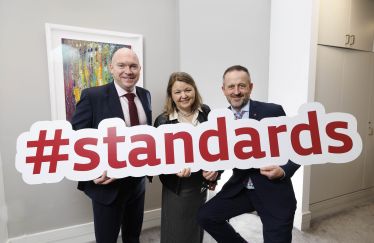- Standard is used to assess and categorise pyrite affected homes
- Standard is being updated to reflect on-site experiences and evidence gathered by engineers and geologists during the past three years
- Public can give feedback until December 17th 2016
Listen to NSAI's Technical Standards Manager Yvonne Wylde explain why the proposed Reactive Pyrites standard, I.S. 398-1 is being revised and how homeowners who have been affected by pyrite, engineers, geologists and other technical experts can have their say during the public consultation period.
The National Standards Authority of Ireland (NSAI) has decided to extend the public consultation period for a proposed revision to the standard, which is used to assess and categorise homes affected by pyrite.
NSAI has so far received over 100 submissions to the draft revised standard I.S. 398-1 since it opened for public consultation on October 13th.
Due to the high volume of interest and submissions, NSAI has now decided to extend the consultation period to December 17th. This will allow homeowners who have been affected by pyrite, technical experts who use the standard, or indeed the general public, more time to review the document and have their say.
- Please log onto NSAI Your Standards, Your Say to make your submission.
NSAI would like to thank all those who have already submitted comments, which will be considered by the standards committee.
Why is the standard being updated?
In 2013, the NSAI’s Reactive Pyrite Technical Committee developed a standard (called I.S. 398-1) which is used by engineers, surveyors, geologists and other technical experts, when assessing buildings affected by pyrite.
The NSAI’s Reactive Pyrite Technical Committee is made up of engineers, geologists, academics and other technical experts. NSAI’s consultative process facilitates inputs and co-ordinates the development of the standard.
The standard aims to establish a test protocol to enable a building to be categorised in terms of the risk of pyritic heave. The standard is being updated and revised to reflect the on-site experiences and evidence gathered by technical experts who have been using the standard during the past three years.
As anyone who has been affected by pyrite will know, pyrite is unpredictable. NSAI’s Reactive Pyrite Technical Committee’s objective is for this revised standard to further reduce the possibility of ambiguity in deciding and interpreting results, and give more clarity to the categorisation process.
What are the main proposed changes?
The standard (I.S. 398-1) maps out the ways of determining if the damage caused to the home or building is attributable to pyrite. It looks at many areas such as damage to ground floor, fixtures and fittings, walls/partitions on the ground floor, ground floor ceiling and external walls.
Revisions have been made to the criteria in the evaluation of visual damage assessment carried out by the engineer, based on experience and evidence gathered over the last three years.
It is envisaged that this revision will give engineers a more comprehensive and precise way of assessing buildings for pyrite damage.
In the revised standard, there has been an increase in the number and type of attributes or characteristics evaluated for damage during the assessment.
For example, it’s now proposed that extra attributes will be included in the ground floor slab element group and kitchen worktops will be evaluated in the fixtures and fittings element group.
Changes have also been proposed to the testing regime of the hardcore samples. Another test has been added, called the PSD (Particle Size Distribution) test. This will give geologists a more comprehensive result.
There is also a new clause in the revised standard allowing geologists to call for more tests to be conducted if necessary, ensuring a more conclusive result is obtained.
Under the proposed draft standard, the engineer can categorise the property as being of ‘Negligible Risk’ (Category A), ‘Low Risk’ (Category B), ‘Medium Risk’ (Category C) or ‘Significant Pyrite Damage’ (Category D). Each category relates to the potential for pyritic heave.
Who is responsible for remediation?
The Pyrite Resolution Board is responsible for the pyrite remediation scheme.
The decision on whom or what category of building qualifies for remediation of damage caused by pyrite is governed by the Pyrite Resolution Board; not the NSAI.
The Pyrite Resolution Board currently reference I.S. 398-1 when assessing buildings damaged by pyrite. But according to legislation, another document could be used if decided by the Minister.
According to the Pyrite Resolution Act 2013, “The Minister having considered any revision or replacement by the NSAI of the IS 398-1 may prescribe amendments to, revisions of or replacement of the standard for testing.”
What happens once the public consultation period ends?
All comments and feedback submitted to the NSAI on this proposed draft standard will be given to the NSAI’s Reactive Pyrite Technical Committee, once the deadline for submissions closes on December 17th 2016.
Like any standard developed by NSAI, the technical standards committee will then consider each of the comments and decide by consensus whether the comment is accepted or not and the draft standard revised accordingly. It is anticipated that the new I.S. 398-1 standard will be published in early 2017.
NSAI is encouraging all stakeholders including homeowners, engineers and geologists to have their say on the proposed standard. NSAI can only consider technical comments relating to the standard.
Any comments we receive relating to the Pyrite Resolution Board remediation scheme will be submitted to the Pyrite Resolution Board.
- To have your say on the draft revised standard, click on I.S. 398-1



